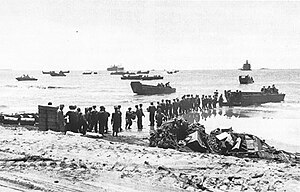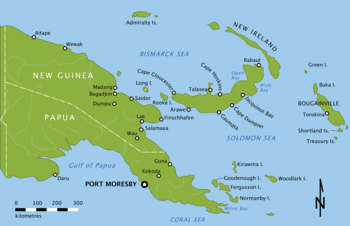Landing at Aitape
| Landing at Aitape | |||||||
|---|---|---|---|---|---|---|---|
| Part of the New Guinea Campaign | |||||||
 Troops unloading supplies at Aitape | |||||||
| |||||||
| Belligerents | |||||||
|
|
| ||||||
| Commanders and leaders | |||||||
|
|
| ||||||
| Units involved | |||||||
| Strength | |||||||
| 22,500 | 1,000 | ||||||
| Casualties and losses | |||||||
|
19 killed 40 wounded |
525 killed 25 captured | ||||||
The Landing at Aitape (code-named Operation Persecution) was a battle of the Western New Guinea campaign of World War II. American and Allied forces undertook an amphibious landing on 22 April 1944 at Aitape on the northern coast of Papua New Guinea. The amphibious landing was undertaken simultaneously with the landings at Humboldt and Tanahmerah Bays to secure Hollandia to isolate the Japanese 18th Army at Wewak. Operations in the area to consolidate the landing continued until 4 May, although US and Japanese forces fought further actions in western New Guinea following a Japanese counter-offensive that lasted until early August 1944. Aitape was subsequently developed into an Allied base of operations and was used by Australian forces throughout late 1944 and into 1945 during the Aitape–Wewak campaign.
Background

The objective was to isolate the Japanese
Operations Reckless and Persecution were supported by 217 ships, along with almost 23,000 personnel of all types of service units, to transport and protect the 52,000 men, their equipment, and supplies over 1,000 mi (1,600 km) to conduct the separate amphibious landings at Aitape and Hollandia deep in Japanese territory.
A naval bombardment, carried out by Task Force 58 led by Vice Admiral
Landings

The Allied ground force assigned to the landing at Aitape was commanded by
The shipping and troops assigned to the operation by the Allies staged out of
The landings were planned at "Blue Beach", a 1,200-yard (1,100 m) beach about 1 mile (1.6 km) from Tadji Airfield.[16] Obscured by heavy smoke from fires from the beachhead, the crews of the landing craft became disorientated and came ashore at the wrong place, landing at Wapil on 22 April 1944.[18] Two battalions of the 163rd Regimental Combat Team landed in nine waves against only light opposition Initially, the only resistance they encountered from consisted of only a few rifle shots, with most Japanese defenders fleeing into the hills as the overwhelming force continued to arrive.[18]
After the beachhead had been secured, No. 62 Works Wing of the Royal Australian Air Force (RAAF) went ashore on the morning of 22 April to help secure and repair Tadji Airfield. MacArthur watched the landings from a light cruiser, then went ashore in a landing boat.[19]

The main airfield was secured by 13:00 on 22 April, and on 23 April, infantry secured incomplete Tadji west strip.[20] The fighter strip was made operational by the RAAF No. 62 Works Wing within 48 hours after working nonstop. Twenty-five P-40s from the No. 78 Wing of the RAAF landed on the field on 24 April, with the rest of the wing arriving the next day to provide support to the Aitape and Hollandia landings.[19] While securing areas westward of the airfield strip, the 163d Infantry Regiment did not encounter much resistance, only suffering two casualties, one man wounded and another missing.[21] The second echelon of Allied troops arrived on 23 April, with the 127th Infantry Regiment arriving from the 32nd Infantry Division.[22] The following day on 24 April, infantry and tanks proceeded further west, crossed the Raihu river without much resistance, reaching Aitap town and Rohm Point, which had been hastily abandoned by their Japanese defenders.[21]
Allied troops then decided on going up the Raihu river, in order to hunt down remaining Japanese stragglers who hoped to go either east toward Wewak or west toward Vanimo,[23][15] the closest strongholds still in Japanese hands. On 28 and 29 April, upon reaching Kamti village, around present day Paiawa, members of the 3rd Battalion encountered the only signs of organized Japanese resistance found in the Aitape area to 4 May. An estimated 200 Japanese launched a number of harassing attacks, resulting in heavy losses for them. The Japanese lost about 90 men while members of the 3rd Battalion only lost 3 men and 2 wounded. On 30 April the men at Kamti withdrew while Battery A, 126th Field Artillery Battalion, fired 240 rounds of 105 mm ammunition into the village and its environs. The next morning Company L, 163d Infantry Battalion, moved back to Kamti against no opposition. There were few further contacts with the Japanese on the west flank and all outposts of the 163d Infantry Battalion were relieved by 32d Division troops early in May.[24][25]
Aftermath
Casualties and analysis
Between 22 April and 4 May, Japanese casualties in the Aitape area were estimated at 525 killed, and during the same period 25 were captured. Allied losses were 19 killed and 40 wounded. All of these were American, and exception for two or three all were suffered by the 163d Infantry.[15] During the operation, only one landing force transport was damaged by Japanese aircraft. The transport Etami was attacked by three Japanese torpedo bombers on 27 April. The vessel caught fire with a large amount of cargo on board, but the fire was brought under control and the ship towed to Finschhafen.[26] Efforts to improve the second strip so that it could be used by bombers continued, and the strip ultimately was not ready until July.[27]
The landings at Aitape, along those of Hollandia, effectively contributed to strengthening the Allied push toward western New Guinea and the Philippines, while successfully bypassing and cutting off large Japanese forces at Wewak. The area ultimately proved less suitable for the development of airbases than the Allies had assessed,

Subsequent operations
Following the securing of the perimeter around Aitape and Tadji Airfields, American troops of the 32d Infantry Division started probing Japanese forces east of Tadji Airfield, in case of a possible counterattack by the 18th Army, now cut off from western New Guinea, by setting up new outposts along the rivers leading to Wewak.
The Japanese, growing increasingly concerned of this threat on their western flank, decided to act on by taking a more offensive stance.[35] Between 15 May up until 5 June, under constant harassment and skirmishes, troops of the 127th Infantry Regiment decided to retreat first to Babiang which they had occupied five days before, only to be beaten back, driving them to flee to Nyaparake and Parakovio (the HQs of the Nyaparake Force), which turned out to be impossible to hold as well, and from which they had to depart on 24 May.[36] Eventually, they made a last attempt at delaying the Japanese at Yakumol on 4 June, before being compelled to retreat by sea the following night under constant artillery shelling, relocating on a defensive line along the west bank of the Driniumor River.[37] Several hundred Japanese and dozens of Americans died during those actions.[38]

Those constant and well organized attacks, along with intelligence provided by documents captured by AIB patrols at the end of May, indicated that the Japanese 18th Army, using 20th and 41st Divisions based at Wewak and its surroundings, were preparing something much bigger.[39] Having broken Japanese codes earlier in the war, they found out that Adachi planned to retake Tadji Airfield, in order to delay the American forces push toward Western New Guinea and the Philippines.[40][41]
During June, American forces started reinforcing their position at Anamo and Afua along the Driniumor River, with some patrols venturing eastward of the river to keep contact with the Japanese.[42] The Japanese kept moving more troops from Wewak to the area, which would lead to the Battle of Driniumor River in July.[43] Heavy fighting continued in the area continued throughout July and into early August, before the Japanese began withdrawing as they depleted their rations and supplies of artillery ammunition. The period between late April and early August resulted in heavier casualties than the original landing: 440 Allied soldiers were killed and 2,550 were wounded during this period, while 9,000 of the 20,000 Japanese soldiers committed to the fighting were lost.[44] In November 1944, Australian forces took over from the US troops around Aitape, and from then until the end of the war in August 1945, began a limited campaign in the Aitape–Wewak area, utilizing Aitape as their base of operations as they advanced towards Wewak and into the Torricellis.[45]
References
- ISBN 978-1-4102-2507-8.
- ISBN 0-8920-1046-0.
- ^ "Wewak: The Australian Advance, 1944–45". Australian War Memorial London. Retrieved 19 January 2020.
- ISBN 978-1-4102-2507-8.
- OCLC 7185705.
- ISBN 978-1-4102-2507-8.
- ISBN 1-4325-8817-6.
- ISBN 978-1-4102-2507-8.
- ISBN 0313313954.
- ISBN 0-7858-2752-8.
- ISBN 978-1-4102-2507-8.
- OCLC 637329967.
- ISBN 978-1-4102-2507-8.
- ISBN 978-1-4102-2507-8.
- ^ ISBN 978-1-4102-2507-8.
- ^ OCLC 637329967.
- ISBN 978-1-4102-2507-8.
- ^ ISBN 978-1-4102-2507-8.
- ^ ISBN 978-1-4102-2507-8.
- ISBN 978-1-4102-2507-8.
- ^ ISBN 978-1-4102-2507-8.
- ISBN 978-0-25207-038-9.
- ^ "Vanimo, West Sepik Province, Papua New Guinea (PNG)". Pacific Wrecks. Retrieved 19 January 2020.
- ISBN 1-6816-2213-0
- ISBN 978-1-4102-2507-8.
- ISBN 978-0-25207-038-9.
- OCLC 7185705.
- ISBN 978-1-59555-394-2.
- OCLC 7185705.
- ISBN 978-1-4102-2507-8.
- ISBN 978-1-4102-2507-8.
- ISBN 978-1-4102-2507-8.
- ISBN 978-1-4102-2507-8.
- ISBN 978-1-4102-2507-8.
- ISBN 978-1-4102-2507-8.
- ISBN 978-1-4102-2507-8.
- ISBN 978-1-4102-2507-8.
- ISBN 978-1-4102-2507-8.
- ISBN 978-1-4102-2507-8.
- ^ Drea, Edward J. New Guinea, CMH Pub 72-9. The U.S. Army Campaigns of World War II. Center for Military History. Retrieved 19 January 2020.
- OCLC 777996740.
- ISBN 978-1-4102-2507-8.
- ISBN 978-1-4102-2507-8.
- OCLC 7185705.
- OCLC 7185705.
External links
- US Army in WW2 – The Approach to the Philippines (Chapter II – Planning and Preparation for the Hollandia-Aitape Operation)
- US Army in WW2 – The Approach to the Philippines (Chapter V – Prelude to the Battle of the Driniumor)
- US Army in WW2 – The Approach to the Philippines (Chapter VI – Deployment for Battle)
